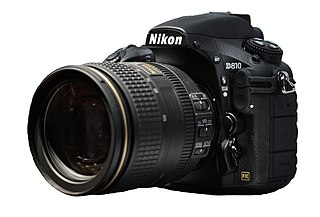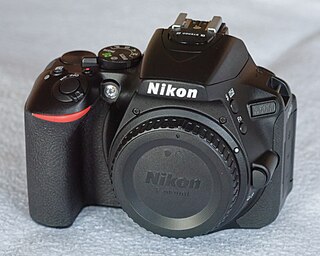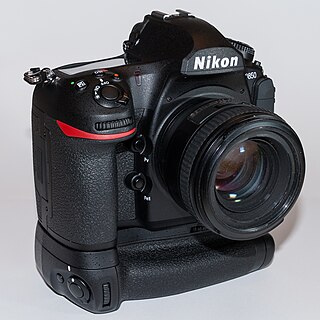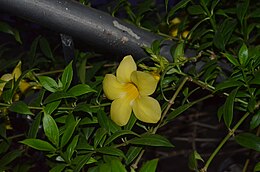
The Nikon D200 is a 10.2-megapixel digital single-lens reflex camera that falls between entry-level/midrange DSLR cameras such as the Nikon D40, Nikon D40x, and D80 and high-end models such as the Nikon D2Hs and D2Xs. It was released by the Nikon Corporation in November 2005. The D200 was succeeded by the D300 in August 2007.

The Nikon D300 is a 12.3-megapixel semi-professional DX format digital single-lens reflex camera that Nikon Corporation announced on 23 August 2007 along with the Nikon D3 FX format camera. The D300 was discontinued by Nikon on September 11, 2009, being replaced by the modified Nikon D300S, which was released July 30, 2009. The D300S remained the premier Nikon DX camera until the D7100 was released in early 2013.

The Nikon D700 is a professional-grade full-frame digital single-lens reflex camera introduced by the Nikon Corporation in July 2008 and manufactured in Japan. It uses the same 12.1-megapixel "FX" CMOS image sensor as the Nikon D3, and is Nikon's second full-frame digital SLR camera.

The Nikon D90 is a 12.3 megapixel digital single-lens reflex camera (DSLR) model announced by Nikon on August 27, 2008. It is a prosumer model that replaces the Nikon D80, fitting between the company's entry-level and professional DSLR models. It has a Nikon DX format crop sensor.

The D5000 is a 12.3-megapixel DX-format DSLR Nikon F-mount camera, announced by Nikon on 14 April 2009. The D5000 has many features in common with the D90. It features a 2.7-inch 230,000-dot resolution tilt-and-swivel LCD monitor, live view, ISO 200–3200, 3D tracking Multi-CAM1000 11-point AF system, active D-Lighting system and automatic correction of lateral chromatic aberration. The D5000 seems to have been discontinued in November 2010.

The Nikon D3000 is a 10.2-megapixel DX format DSLR Nikon F-mount camera announced by Nikon on 30 July 2009. It replaces the D40 as Nikon's entry level DSLR. It features a 3.0-inch 230,000-dot resolution LCD monitor, CCD sensor with ISO 100–1600 and 3D tracking Multi-CAM1000 11-point AF system which makes it quite similar to the Nikon D200 in these main parts. Initially priced with $599 MSRP, actual prices are much lower.

The Nikon D300S is a 12.3-megapixel DX format digital single-lens reflex camera (DSLR) announced by Nikon on 30 July 2009. It replaced the D300 as Nikon's flagship DX format DSLR adding HD video recording. It has some similarities to the Nikon D700, with the same resolution, but has a smaller, higher-density sensor. The D300s was superseded by the Nikon D500, announced on January 5, 2016.

The Nikon D3100 is a 14.2-megapixel DX format DSLR Nikon F-mount camera announced by Nikon on August 19, 2010. It replaced the D3000 as Nikon's entry level DSLR. It introduced Nikon's new EXPEED 2 image processor and was the first Nikon DSLR featuring full high-definition video recording with full-time autofocus and H.264 compression, instead of Motion JPEG compression. It was also the first Nikon DSLR to provide high-definition video recording at more than one frame rate.

The Nikon D7000 is a 16.2-megapixel digital single-lens reflex camera (DSLR) model announced by Nikon on September 15, 2010. It replaced the D90 as the top end consumer camera, by using much of the technology and controls from the earlier D5000, in a larger more robust body similar to the flagship D300 series. In some ways it was superior to the D300S, though for several years the two cameras were both available with the D300 positioned as the flagship in Nikon marketing materials.

The Nikon D800 is a 36.3-megapixel professional-grade full-frame digital single-lens reflex camera produced by Nikon Corporation. It was given a Gold Award by Digital Photography Review.

The Nikon D4 is a 16.2-megapixel professional-grade full frame (35mm) digital single-lens reflex camera (DSLR) announced by Nikon Corporation on 6 January 2012. It succeeds the Nikon D3S and introduces a number of improvements including a 16.2 megapixel sensor, improved auto-focus and metering sensors and the ability to shoot at an extended ISO speed of 204,800. The camera was released in February 2012 at a recommended retail price of $5999.95. It is the first camera to use the new XQD memory cards. It was replaced by the Nikon D4S as Nikon's flagship camera.

The Nikon Expeed image/video processors are media processors for Nikon's digital cameras. They perform a large number of tasks: Bayer filtering, demosaicing, image sensor corrections/dark-frame subtraction, image noise reduction, image sharpening, image scaling, gamma correction, image enhancement/Active D-Lighting, colorspace conversion, chroma subsampling, framerate conversion, lens distortion/chromatic aberration correction, image compression/JPEG encoding, video compression, display/video interface driving, digital image editing, face detection, audio processing/compression/encoding and computer data storage/data transmission.

The Nikon D3200 is a 24.2-megapixel DX format DSLR Nikon F-mount camera officially launched by Nikon on April 19, 2012. It is marketed as an entry-level DSLR camera for beginners and experienced DSLR hobbyists who are ready for more advanced specs and performance.

The Nikon D5200 is an F-mount DSLR camera with a newly developed 24.1-megapixel DX-format CMOS image sensor first announced by Nikon on November 6, 2012 for most of the world and January 7, 2013 for the North American market.

The Nikon D7100 is a 24.1-megapixel digital single-lens reflex camera model announced by Nikon in February 2013. It is a 'prosumer' model that replaces the Nikon D7000 as Nikon's flagship DX-format camera, fitting between the company's entry-level and professional DSLR models. This camera is the first ever from Nikon with no optical low-pass filter incorporated. At launch, Nikon gave the D7100 estimated selling price in the United States as US$ 949.95 for the body.

The Nikon D5300 is an F-mount DSLR with a carbon-fiber-reinforced polymer body and other new technologies, announced by Nikon on October 17, 2013. It is a mid-range camera with a crop sensor and requires a minimum camera 8.3 raw plugin for Photoshop to process its .NEF files.

The Nikon D810 is a 36.3-megapixel professional-grade full-frame digital single-lens reflex camera produced by Nikon. The camera was officially announced in June 2014, and became available in July 2014.

The Nikon D5600 is a 24.2 megapixel upper-entry level, APS-C sensor DSLR announced by Nikon on November 10, 2016, as the successor of the D5500. The camera has an F-mount.

The Nikon D7500 is a 20.9-megapixel digital single-lens reflex camera using an APS-C sensor. It was announced by Nikon Corporation on 12 April 2017, and started shipping on 2 June 2017. It is the successor to the Nikon D7200 as Nikon's DX format midrange DSLR.

The Nikon D850 is a professional-grade full-frame digital single-lens reflex camera (DSLR) produced by Nikon. The camera was officially announced on July 25, 2017, launched on August 24, 2017, and first shipped on September 8, 2017. Nikon announced it could not fill the preorders on August 28, 2017 and filled less than 10% of preorders on the first shipping day. It is the successor to the Nikon D810.






















